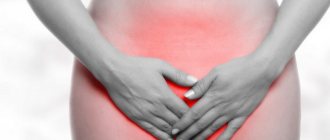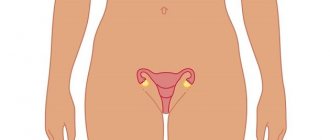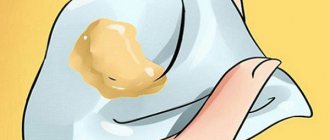December 21, Valeri
Dark discharge after childbirth (lochia) appears in a woman in labor due to the regeneration of the mucous layer of the uterus. They contain desquamated epithelial cells, a small amount of blood and plasma, and last on average one and a half months.
A young mother needs to closely monitor her health during the postpartum period, monitor body temperature, localization of pain and the amount of lochia. If the rules of personal hygiene are not observed, any infection that gets to the female genital organs can provoke inflammation of the mucous layer of the uterus, which will cause the development of the disease.
How long does discharge last after childbirth?
How long does discharge last after childbirth? In general, postpartum discharge has the scientific name of lochia. They begin to appear from the moment of postnatal rejection and usually persist for 7-8 weeks. Over time, the lochia secretes less and less, their color begins to become lighter and lighter, and then the discharge stops.
However, it is impossible to answer the question of how long the discharge lasts after the end of labor, since it depends on several factors:
- The physiological characteristics of each woman are different, including the body’s ability to quickly recover after childbirth.
- The course of pregnancy itself.
- The process of childbirth.
- Intensity of uterine contraction.
- Presence of complications after childbirth.
- Breastfeeding a child (if a woman breastfeeds her baby, the uterus contracts and cleanses much faster).
But, on average, remember, discharge lasts about 1.5 months. During this time, the body gradually recovers from pregnancy and childbirth. If the lochia ends a couple of days or weeks after giving birth, you should seek help from specialists, since your uterus is not contracting properly, and this is fraught with serious complications. The same applies to situations where the discharge does not stop for quite a long time, which may indicate bleeding, polyps in the uterus, an inflammatory process, etc.
Normal indicators
Heavy discharge is observed in the first 1–2 hours after delivery. The quantity and composition are controlled by the obstetrician. It is recommended that the woman in labor be covered with a gynecological diaper so that the doctor can correctly assess the intensity and exclude uterine bleeding.
At the beginning, the discharge consists of 80% blood and has a sweetish odor. The rest (20%) is a secret secreted by the glands of the uterus for the speedy renewal and healing of the mucous layer of the uterus. The intensity of lochia will begin to decrease after 3–5 days, from 400 ml to 30–60 ml. Will stop completely after 5-9 weeks.
Blood clots observed in the first days disappear after 6–10 days. Dark brown discharge after childbirth replaces red lochia and continues for up to three weeks. At the end, mucous discharge begins, indicating healing of the uterine cavity.
The first two hours after delivery
The woman in labor is left in the inpatient department, cold lotions are applied to the lower abdomen and the amount of bleeding is monitored. The normal parameter is considered to be no more than 0.5% of a young mother’s body weight. Emptying the bladder is carried out through a catheter so as not to provoke increased discharge.
The first two days after delivery
Most of the mucus is added to the blood discharge, and clots appear. Every day the quantity decreases, the color darkens. If there are no complications, the mother in labor is discharged from the maternity hospital.
The first two weeks after birth
During the postpartum period, a woman will secrete about 1.5 liters of lochia. Dark discharge becomes lighter, with the appearance of a whitish-yellow tint. Sometimes a pink color appears - this is not considered a pathology. There is an increased content of mucus in the lochia. By the end of the fourth week, the discharge begins to smear, and this happens until it completely disappears.
Discharge one month after birth
Heavy discharge in the first month is quite desirable - this way the uterine cavity is cleaned. In addition, microbial flora is formed in the lochia after childbirth, which can subsequently cause all sorts of inflammatory processes within the body.
At this time, it is necessary to carefully observe personal hygiene, because a bleeding wound can become infected. Therefore you should:
- After visiting the toilet, thoroughly wash your genitals. It is necessary to wash with warm water, and from the outside, not the inside.
- You cannot swim, shower, or take a bath every day after giving birth.
- in the first weeks and days after childbirth, use sterile diapers rather than sanitary pads.
- for a certain time after childbirth, change pads 7-8 times a day.
- forget about using sanitary tampons.
Remember that after a month the discharge should become a little lighter, because soon it should stop altogether. Continue to practice good hygiene and don't worry, everything is going according to plan.
If the discharge continues a month after birth and it is profuse, has an unpleasant odor, and is mucous, then consult a doctor immediately! Do not delay, it may be dangerous to your health!
Thrush
In the postpartum period, a woman’s immunity is low: this is due to blood loss, severe stress due to childbirth, as well as a physiological decrease in immunity during pregnancy. Often, a woman is prescribed the installation of a pessary in case of severe weakening of the pelvic floor muscles. All these events provoke fungal pathology in the woman’s genital tract. In this case, the discharge will be thick, white, with a cheesy consistency, with large flakes and films, and a strong sour odor. In this case, itching and burning of the external genitalia and vagina are noted.
The symptoms leave no doubt that the woman has candidiasis. Microscopy of a vaginal smear reveals spores and mycelium threads. In such cases, antimycotic drugs are prescribed. “Flucostat” has proven itself well, which, even after a single dose, allows you to quickly eliminate unpleasant symptoms.
Bloody discharge after childbirth
A large amount of blood and mucus is released from a woman immediately after she gives birth to a baby, although this is how it should be. All this happens due to the fact that the surface of the uterus is damaged, since there is now a wound there from the attachment of the placenta. Therefore, bleeding will continue until the wound on the surface of the uterus heals.
It should be understood that bloody discharge should not be more than the permissible norm. You can find out about this very easily - if there is excessive secretion, the diaper or sheet under you will be all wet. You should also be concerned if you feel any pain in the uterine area or the discharge comes in jerks in rhythm with your heartbeat, which indicates bleeding. In this case, seek medical advice immediately.
Lochia will gradually change. At first it will be a discharge that is similar to the discharge during menstruation, only much larger, then it will acquire a brownish color, then yellowish-white, lighter and lighter.
Some women experience bleeding after childbirth, but at first they think it is harmless spotting. To avoid bleeding, you must:
- Visit the toilet regularly - the bladder should not put pressure on the uterus, thereby preventing its contraction.
- Constantly lie on your stomach (the uterine cavity will be cleared of contents from the wound).
- Place a heating pad with ice on the lower abdomen in the delivery room (in general, obstetricians should do this by default).
- Avoid heavy physical activity.
Causes
There are a lot of factors that influence the fact that menstruation changes a lot after childbirth. Only a doctor can determine the cause for a specific case after a frank conversation, personal examination and a thorough examination.
Among the most common influencing factors are:
- Excess weight.
- Diabetes.
- Thyroid gland dysfunction.
- Kidney disease.
- Abuse of birth control pills or incorrect choice of contraceptives.
- Abrupt climate change.
- Pathologies in the development of the uterus or its appendages.
- Abortion or miscarriage.
- Overwork and stressful situations.
- Intense physical activity on the body.
- Lack of sleep and proper rest.
- Inflammation of the ovaries or uterus.
- Recent hypothermia.
- Infectious diseases, viruses.
- Surgical interventions.
- Hormonal disbalance.
- Injuries received.
- Anemia (anemia).
- Metabolic disorder (metabolism in the body).
- Deficiency of vitamins of certain groups.
- Anorexia or sudden weight loss.
- Chronic fatigue.
- Following an unbalanced diet or fasting.
- Diseases of the endocrine system.
Brown discharge after childbirth
Brown discharge is especially scary for most mothers, especially if it causes an unpleasant odor. And if you read everything about medicine, and gynecology in particular, then you know that this is an irreversible process that should be waited out. At this time, dead particles and some blood cells come out.
In the first hours after the end of labor, the discharge may already acquire a brown tint, along with large blood clots. But, basically, the first few days of lochia will be purely bloody.
If the recovery period for a woman passes without complications, on the 5th-6th day the discharge will turn brownish. An interesting fact is that brown discharge ends much earlier in those mothers who breastfeed their children. The reason for this is the following - lactation favors rapid contraction of the uterus.
At the same time, brown lochia lasts longer in those women who had to have a cesarean section.
However, if there is a strong purulent odor with the brown discharge, pay close attention to this. After all, a possible reason for this phenomenon is an infection introduced into the body. Therefore, in this case, seek medical help immediately.
After a miscarriage
After an unsuccessful pregnancy, hypomenorrhea is a common manifestation. In this case, particles of the fetus, membranes of the amniotic sac, and blood from the vessels of the endometrium of the uterus are released.
Also, the discharge may become scanty due to adhesions and scars that sometimes form after a miscarriage.
A suddenly terminated pregnancy is manifested by a sudden hormonal disruption, which causes temporary disruption of the menstrual cycle.
As a rule, the cycle should return to normal within about 2 months. If this does not happen, then prolonged scanty periods after a miscarriage may be symptoms of hormonal pathology or infection, which requires consultation with a doctor.
Yellow discharge after childbirth
The discharge acquires a yellowish tint approximately ten days after childbirth. The uterus is gradually recovering, and the yellow discharge only confirms this fact. During this time, it is important to breastfeed your baby and also remember to empty your bladder on time. Thus, the yellow discharge will stop faster, and the uterus will return to its original prenatal state.
However, if immediately after the birth of your baby you notice that you have discharge of a bright yellow color or with a green admixture, you should tell your doctor about it. After all, such lochia can be caused by inflammatory processes occurring in a woman’s body. In addition, discharge of this color is usually accompanied by high fever and unpleasant sensations in the lower abdomen.
It is possible that suppuration has occurred in the uterine cavity, so you should seek help from a gynecologist who will refer you for an ultrasound.
Remember that yellow discharge caused by infection usually has a strong, purulent odor. To avoid such consequences, it is necessary to maintain personal hygiene and also be under the supervision of a doctor.
But in general, yellow discharge is a common occurrence and it only confirms that everything is proceeding as expected.
After an abortion
Abortion is both a serious stress for a woman’s nervous system and a “shake-up” for the body’s hormonal system.
During an abortion, trauma is caused: the inner layer of the uterus is scraped out, the pregnancy is interrupted and a sharp hormonal change occurs. All this certainly leads to cycle disruption, one of which is hypomenorrhea.
The consequences of hormonal imbalance lead to the fact that as the body recovers, normal periods can be restored up to six months. It happens that menstruation resumes earlier after an abortion. It all depends on the type of abortion, the correct execution of the procedure, and the stage of pregnancy.
Scanty menstruation is sometimes observed after an abortion and lasts up to 7 days as a reaction of the uterus to the procedure. They are also often observed after a medical abortion in the form of spotting that lasts from 1 to 3 days and recurs at intervals of a week.
If, along with the described course of the period after the abortion, pain appears in the left side or on both sides, pain in the lower abdomen, and the discharge has an unpleasant odor, then an examination by a gynecologist is necessary.
Vaginosis
The appearance of copious transparent or yellow discharge with an unpleasant fishy odor indicates bacterial vaginosis (vaginal dysbiosis). This disease develops due to the suppression of normal microflora, represented by lactobacilli, which normally colonize the vaginal epithelium, creating a highly acidic environment. During the development of this pathology, lactobacilli are replaced by other microflora, most often gardnerella.
Microscopically, dysbiosis manifests itself as “key cells” and a pattern of microflora replacement. The source of Gardnerella can be a woman’s sexual partner, but given that in a significant proportion of cases Gardnerella is sown from the contents of the rectum, one should not miss the possibility of recolonization of the vagina with Gardnerella of rectal origin. It is for this reason that the persistent recommendation for women to take one glass of yogurt every day throughout pregnancy becomes clear: this suppresses the development of intestinal dysbiosis and returns the microflora to its normal profile. Depending on the severity of gardnerellosis, its treatment may begin with antibiotic therapy, but usually the emphasis is on restoring the normal microflora of the vagina and intestines (Linnex, Bifidumbacterin, etc.).
Endometritis
Various pathogenic and opportunistic microflora can lead to postpartum endometritis, the symptoms of which will be: mucopurulent vaginal discharge, nagging pain in the lower abdomen, temperature, fever. There is a correlation between the severity of endometritis and the content of tissue destruction products in the lochia. In this case, curettage is indicated, since most likely the products of labor remain in the uterus. After this, a course of antibiotic therapy, immunostimulants, vitamins, and restoratives are prescribed.
The postpartum period is often accompanied by infectious and inflammatory complications, the source of which lies in the genital and extragenital area and is often represented by old foci of untreated infection.
That is why, when planning childbirth, it is so important to conduct a complete audit of the woman’s body and cure all chronic inflammatory processes. This will reduce the likelihood of complications in the postpartum period and allow the woman to maintain reproductive health for many years to come.
Proper postpartum hygiene
To avoid infectious complications during the postpartum period, a young mother needs to carefully monitor her hygiene. This will also help combat unpleasant odors. Especially the first six weeks, when lochia continues to be released. It is necessary that there is a correct, timely outflow of secretions from the uterine cavity. Otherwise, pathogenic microflora may begin to develop in them, which in most cases leads to inflammation.
Until the lochia is completely gone, the girl must use special postpartum pads. At the same time, it is important to change them very often - at least every three hours. And so the entire first month. Otherwise, pathogenic microorganisms may begin to multiply on them.
But it is better for a young mother to avoid aromatic pads that have any chemical smell in the first postpartum weeks, as they increase the risk of allergies. You should not use tampons, because they can prevent lochia from leaving the body. In this case, mucous postpartum discharge will remain inside. If the girl is lying down, then it is best to simply place a diaper on the surface. Gynecologists often advise refusing to buy ready-made white pads altogether, but rather sewing them for yourself from washed and ironed soft cotton. These reusable, washable homemade pads are said to be highly breathable and reduce the risk of infection. And, besides, it is much more pleasant and comfortable for a young mother to use them. And in the first month, this way you will be able to save significantly on gaskets. Read more about postpartum pads →
In the first weeks, a girl should wash herself not only after changing the pad, but also after every trip to the toilet. Taking a bath during this period is not recommended; it is better to use a warm shower. And how many times a day to take a shower, each girl decides for herself. You need to wash the area around the vagina and labia with water, but never inside. By the way, warm water significantly reduces pain from healing injuries after childbirth. Therefore, during the first month you can wash the perineum directly during urination, since urine can greatly irritate the wounds and cause an unpleasant stinging pain.
In no case should you do intravaginal douching. This is especially true for special vaginal douches. The genitals can only be washed externally for several days after the birth process. This is necessary to wash away the discharge after childbirth, but not to damage the existing wounds.
Physiology
Through uterine contractions, the body tries to get rid of all the excess that has accumulated during gestation and childbirth - remnants of the placenta, the old thickened layer of the endometrium, excess fluid, plasma, mucus from the cervical canal and other postpartum discharge.
This process occurs in several stages:
| Postpartum period | Lochia color | Abundance of lochia | Character and reason |
| 0–3 days | red | abundant | bleeding due to ruptured blood vessels and an open wound in the uterus |
| 3–4 days | bloody-serous |
| |
| 5–7 days | brown | average | the amount of clots and mucus decreases |
| 7–10 days | light brown | meager | lochia has a thick consistency without inclusions |
| 10–15 days | are intensifying | discharge after childbirth increases due to the formation of a scab during the healing of the uterus | |
| 15–50 days | transparent with a yellow tint | strokes | almost no discharge is observed due to the restoration of the endometrium |
Many mothers are interested in how long the discharge lasts after childbirth. They usually last one and a half to two months, but deviations are possible, so the total period is 4–9 weeks. By this point, the function of endometrial formation has been completely restored; within a few weeks, the egg may mature, and after a month, menstruation can begin.
During the first week, lochia smells musty, damp, and even musty—this is normal. A sharp, sour and putrid smell should alert you.
In nursing women, lochia usually ends after 4–5 weeks, since during lactation the body releases oxytocin, a hormone that promotes contraction of the muscular layer of the uterus. As a result, discharge after childbirth comes out faster, but along with this, pain of varying intensity is observed, reminiscent of contractions. During artificial birth, the uterus contracts less often and, accordingly, heals more slowly, so lochia may be present until the ninth week.
If bleeding occurs later than the fifth postpartum day, you should consult a doctor!











